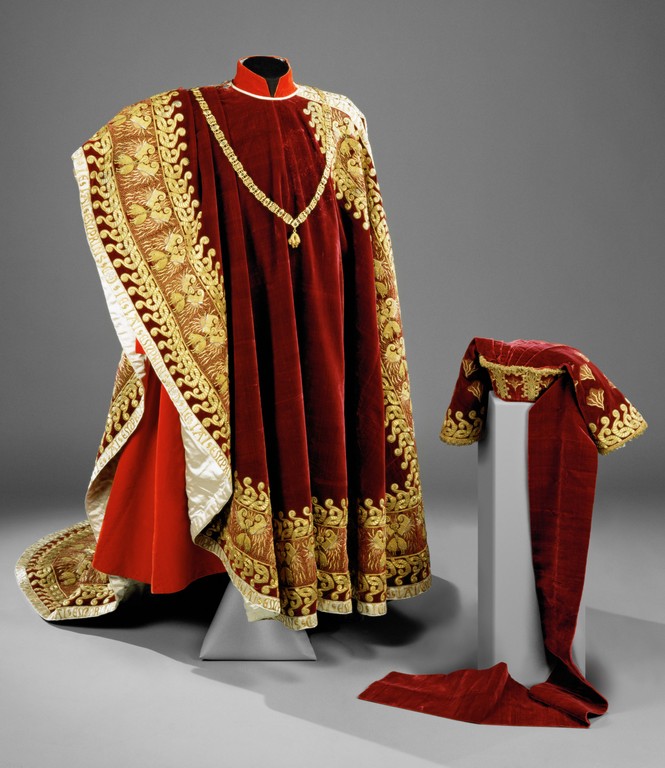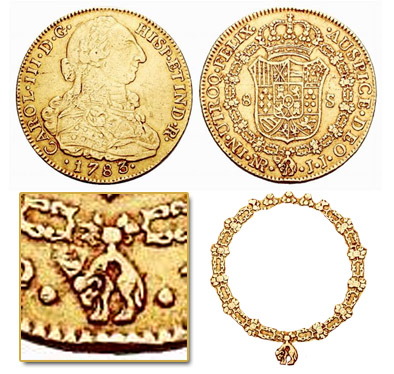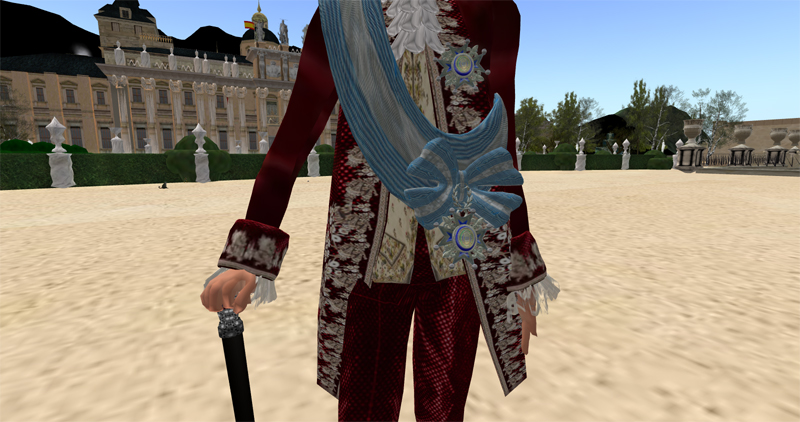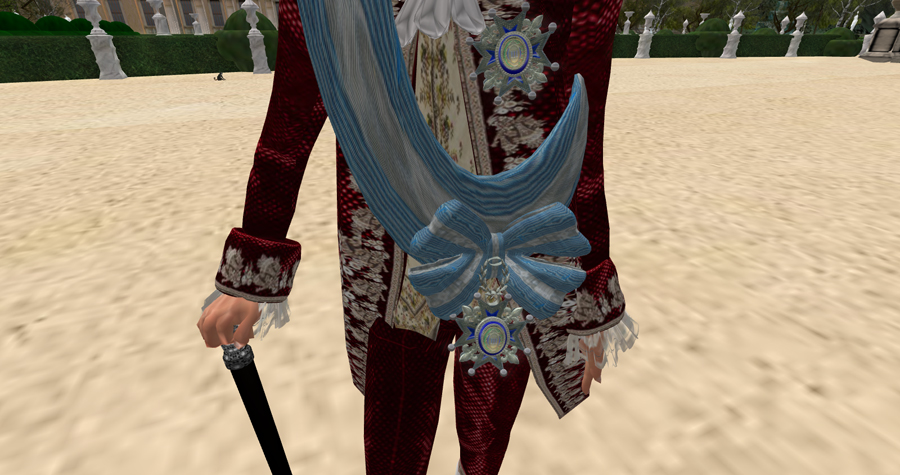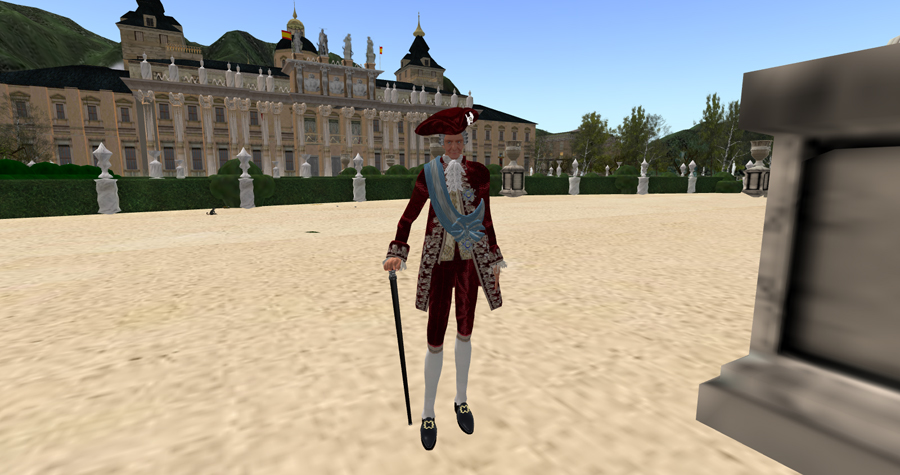The Royal and Distinguished Order of Charles III of Spain.
Communty News & Events
REAL Y DISTINGUIDA ORDEN ESPAOLA DE CARLOS III 
fue establecida por el monarca de este nombre en el ao de 1771. Se trata de la primera Orden nacional espaola, y cuenta con una larga y estimable historia.
was established by the monarch of this name in the year 1771. This is the first Spanish national Order, and has a long and estimable history.
Tras cinco aos de matrimonio, el Prncipe de Asturias an no haba tenido hijos varones; por fin, el 19 de septiembre de 1771 naci en El Escorial el primer Infante, a quien se bautiz aquel mismo da con el nombre de Carlos Clemente Antonio de Pdua Genaro Pascual Jos Francisco de Ass, Francisco de Paula, Luis, Vicente Ferrer y Rafael; lo apadrinaron su abuelo el Rey y el Papa Clemente XIV.
Quiso entonces el Rey, para dejar a la posteridad un pblico y permanente testimonio de su profunda gratitud y reverencia al Altsimo por el imponderable bien que le dispens el Cielo, crear una nueva Orden de caballera, a la que titul de Carlos III, adjetivndola de distinguida y de espaola; y la puso bajo el patrocinio de la Virgen Mara, en su Misterio de la Inmaculada Concepcin, de quien era devotsimo desde muy tierna edad. El fundador se declar jefe y soberano de esta Orden, estableciendo que deban serlo perpetuamente los Reyes de Espaa, sus sucesores. El Real Decreto de creacin y las primeras Constituciones estn fechados el dia del nacimiento del Infante, aunque no se publicaron hasta el 24 de octubre, dia en que la Princesa sali a primera misa despus de parida.
After five years of marriage, the Prince of Asturias had not had sons, at last, on September 19, 1771 was born in El Escorial the first Infante, who was baptized the same day with the name of Carlos Clemente Anthony of Padua Genaro Jos Pascual Francisco de Asis, Francisco de Paula, Luis, Vicente Ferrer, Rafael; sponsored him his grandfather the King and Pope Clement XIV (1). King now wished to leave to posterity a permanent public testimony of his deep gratitude and reverence to the Almighty for the good he dispensed imponderable Heaven, create a new order of knighthood (2), which was titled Carlos III , adjective to distinguish and Spanish, and placed under the patronage of the Virgin Mary in his mystery of the Immaculate Conception, who was very devoted at a very tender age. The chief said founder and ruler of this Order, stating that must be perpetually and Queen of Spain, his successors. The Royal Decree of creation and the first constitutions are dated the day of birth of the infant, though not published until October 24, the day when the Princess came out first mass after calving.

La Orden servira para premiar y distinguir a sujetos benemritos y adeptos a su Persona. En principio, los caballeros eran de dos clases: grandes cruces (limitadas a 60, de ellos cuatro prelados), y pensionados (limitadas a 200, de ellas veinte eclesisticos). En 1783 cre el Rey la clase de caballeros supernumerarios. La nueva Orden estaba reservada a nobles: cada caballero deba presentar un expediente de pruebas de su buena vida y arregladas costumbres, limpieza de sangre hasta sus bisabuelos, y nobleza de sangre -no era admisible la de privilegio- al menos en su lnea paterna, segn las leyes y fueros de Espaa. Al ser recibido, todo caballero juraba vivir y morir en la Fe Catlica; no emplearse jams, directa ni indirectamente, contra la persona del Rey, su Casa y sus dominios; de servir fielmente al Rey si eran sus vasallos; de reconocerle por nico Jefe y Soberano de la Orden; y de cumplir con las Constituciones y Estatutos, en que se comprende la defensa del Misterio de la Inmaculada Concepcin. Como deberes espirituales, todos los caballeros estaban obligados a comulgar una vez al ao, en la vspera o da de la Inmaculada; y a rezar las oraciones cada dia.
The Order would serve to reward and honor the meritorious subjects and followers of his person. In principle, the knights were of two kinds: large crosses (limited to 60, including four bishops) and pensioners (limited to 200, of which twenty church). In 1783 the King created the kind of supernumerary knights. The new order was reserved for nobles, each knight must submit a dossier of evidence of their good life and fixed habits, cleaning blood up to their great-grandparents, and nobility of blood, was not admissible privilege-at least in the male line according to the laws and liberties of Spain. Upon receipt, every knight swore to live and die in the Catholic Faith, not ever used, directly or indirectly against the person of the King, the House and its grounds, to serve faithfully to the King if they were his vassals, to recognize by only Chief and Sovereign of the Order and to comply with the Constitutions and Statutes, which includes the defense of the mystery of the Immaculate Conception. As spiritual duties, all the knights were obliged to receive him once a year, on the eve or day of the Immaculate, and say the prayers every day.
La Orden tena su sede en la iglesia de San Gil de Madrid, donde se celebraban dos Captulos anuales, los das de la Inmaculada, y de Difuntos, en que se ofreca una solemne misa por las nimas del Purgatorio y por el eterno descanso de los caballeros fallecidos. Tambin se investa all a los caballeros pensionados, a menos que asistiese el Rey al Captulo, pues en tal caso esta funcin se verificaba en la Real Capilla, donde tambin se realizaban las investiduras de grandes cruces y ministros. El ceremonial capitular y de investidura fue determinado con todo detalle.
El Papa Clemente XIV, mediante bula despachada el 21 de febrero de 1772, prob y confirm perpetuamente la nueva Orden. Y, adems, concedi notables privilegios y gracias espirituales a caballeros y ministros: que el gran canciller o confesor electo por los caballeros pueda absolverles de cualquier sentencia o censura eclesistica, por graves que fuesen sus delitos -excepto los reservados a la anta Sede-; le daba tambin facultad para conmutar los votos hechos por los caballeros, excepto los de castidad y religin; y le daba facultad para darles la indulgencia plenaria y la bendicin apostlica in articulo mortis. A los caballeros gran cruz y a los ministros les autoriz para tener oratorio privado en sus casas; que en l se dijeran hasta dos misas diarias; que en caso de enfermedad las misas fueran en pieza inmediata a su alcoba; y que en sus viajes pudiesen llevar consigo un altar porttil. Di indulgencia plenaria a todo caballero que confesase y comulgase el dia de su investidura o el dia de la Inmaculada, y adems otras indulgencias en fechas sealadas. Concedi tambin licencia para comer carne, huevos y lacticinios durante la Cuaresma, y que las esposas e hijas de grandes cruces y ministros seculares pudiesen entrar en monasterios y conventos de monjas donde tuviesen parientas de primer o segundo grado, sin pasar la noche en ellos, con licencia del Ordinario y consentimiento de la priora o abadesa. El mismo Pontfice, mediante breve, concedi a la Orden privilegio de nima en su altar de la Inmaculada sito en la Iglesia de San Gil, de frailes menores descalzos: de manera que, mediante los mritos de Nuestro Seor Jesucristo, de la Bienaventurada Virgen Mara y de todos los Santos, se librara de las penas del Purgatorio el alma de cualquiera de los caballeros de la Orden y de sus ministros que, unidos con Dios por la Caridad, hubiesen pasado de esta vida a la otra, siempre que en sufragio suyo se dijera all por un sacerdote la misa de difuntos. Su sucesor el Papa Po VI, por breve de 9 de diciembre de 1783, extendi a los caballeros supernumerarios las gracias espirituales concedidas por Clemente XIV a los dems.
Desde el principio, Don Carlos III anej a la Orden la antigua Junta para tratar de los asuntos relativos al Misterio de la Inmaculada Concepcin, compuesta de eminentes telogos.
Las primeras investiduras de caballeros gran cruz, y de ministros seculares, las realiz el Rey en Madrid en diciembre de 1771:fueron el cardenal de la Cerda, patriarca de las Indias -primer canciller de la Orden-; don Bernardo del Campo, secretario; el marqus de Ovieco, maestro de ceremonias; y el conde de Valparaso, tesorero (estos tres todos juraron en manos de Grimaldi, secretario de Estado). Luego fueron investidos por el Rey los Infantes, y otros treinta y nueve caballeros gran cruz: un capitn general, trece tenientes generales, tres mariscales de campo, el secretario de Guerra -durante este reinado fue evidente el predominio del elemento militar en la nueva Orden-, el cardenal arzobispo de Sevilla, y el de Valencia, y adems varios Grandes de Espaa y otros palatinos.
The Order was based in the church of St. Giles in Madrid, where two chapters were held annually, the days of the Immaculate and the Dead, where a solemn mass was offered for the souls in Purgatory and for the eternal repose of the knights dead. There are also vested gentlemen pensioners, unless attended by the King to the Chapter, since in that case this function is checked at the Royal Chapel, where he also performed the investiture of large crosses and ministers. The ceremonial investiture capitulate and was determined in detail.
Pope Clement XIV, dispatched the bull by February 21, 1772, perpetually tested and confirmed the new order. And also granted privileges and spiritual graces notable gentlemen and ministers, that the chancellor or elected by the knights confessor can absolve them of any ecclesiastical sentence or censure for their crimes were serious, except those reserved to Headquarters-anta; also gave power to switch the votes cast by the knights, except chastity and religion, and gave him authority to give a plenary indulgence and the apostolic blessing in articulo mortis. A large cross knights and ministers were allowed to have private chapel at home, he told that to two daily Masses, that in case of illness Masses were in next room to her bedroom, and that could carry on his travels with a portable altar. He gave a plenary indulgence to every gentleman that confession and communion on the day of his inauguration or the day of the Immaculate Conception, and also other indulgences in dates. Also granted license to eat meat, eggs and dairy products during Lent, and that wives and daughters of great crosses and secular ministers could enter monasteries and nunneries where they had relatives of first or second degree, without spending the night in them, regular licensed and consent of the prioress and abbess. The same Pontiff, by brief privilege granted to the Order bore on its altar of the Immaculate Conception Church located in San Gil, barefoot friars minor, so that, through the merits of our Lord Jesus Christ, the Blessed Virgin Mary and all the Saints, got rid of the pains of Purgatory the soul of any of the knights of the Order and its ministers, united with God by charity, had passed from this life to another, provided that his vote said there is a Mass for the dead priest. His successor, Pope Pius VI, by brief December 9, 1783, the Knights extended supernumerary spiritual graces granted by Clement XIV to others.
From the beginning, Don Carlos III annexed to the former Board Order to deal with matters relating to the mystery of the Immaculate Conception, composed of eminent theologians.
The first investiture of knights grand cross, and secular ministers, was made the King in Madrid in December 1771: were the Cardinal de la Cerda , patriarch of the Indies, first chancellor of the Order- , Don Bernardo del Campo, secretary, the Marquis de Ovieco , master of ceremonies , and the Earl of Valparaiso , treasurer (these three all in the hands of sworn Grimaldi , Secretary of State). They were then invested by the King Infants , and thirty- nine knights grand cross : a captain general , thirteen lieutenant generals , three quarterbacks, the Secretary of War , during this reign was evident the predominance of the military element in the new order - , Cardinal Archbishop of Seville, and Valencia , and also several other grandees of Spain and palate.
updated by @carlos-iii-de-borbon-y-farnesio: 06 Oct 2016 06:09:25AM
 The Order of the Golden Fleece was established January 10, 1430, by Philip the Good, Duke of Burgundy, in celebration of the prosperous and wealthy domains united in his person that ran from Flanders to Switzerland. It is restricted to a limited number of knights, initially 24 but increased to 30 in 1433, and 50 in 1516, plus the sovereign. It received further privileges unusual to any order of knighthood: the sovereign undertook to consult the order before going to war; all disputes between the knights were to be settled by the order; at each chapter the deeds of each knight were held in review, and punishments and admonitions were dealt out to offenders, and to this the sovereign was expressly subject; the knights could claim as of right to be tried by their fellows on charges of rebellion, heresy and treason, and Charles V conferred on the order exclusive jurisdiction over all crimes committed by the knights; the arrest of the offender had to be by warrant signed by at least six knights, and during the process of charge and trial he remained not in prison but in the gentle custody of his fellow knights. The order, conceived in an ecclesiastical spirit in which mass and obsequies were prominent and the knights were seated in choirstalls like canons, was explicitly denied to "heretics", and so became an exclusively Catholic award during the Reformation.
The Order of the Golden Fleece was established January 10, 1430, by Philip the Good, Duke of Burgundy, in celebration of the prosperous and wealthy domains united in his person that ran from Flanders to Switzerland. It is restricted to a limited number of knights, initially 24 but increased to 30 in 1433, and 50 in 1516, plus the sovereign. It received further privileges unusual to any order of knighthood: the sovereign undertook to consult the order before going to war; all disputes between the knights were to be settled by the order; at each chapter the deeds of each knight were held in review, and punishments and admonitions were dealt out to offenders, and to this the sovereign was expressly subject; the knights could claim as of right to be tried by their fellows on charges of rebellion, heresy and treason, and Charles V conferred on the order exclusive jurisdiction over all crimes committed by the knights; the arrest of the offender had to be by warrant signed by at least six knights, and during the process of charge and trial he remained not in prison but in the gentle custody of his fellow knights. The order, conceived in an ecclesiastical spirit in which mass and obsequies were prominent and the knights were seated in choirstalls like canons, was explicitly denied to "heretics", and so became an exclusively Catholic award during the Reformation. on the back (non-royal knights of the Golden Fleece were forbidden to belong to any other order"> recompensa por el trabajo ") grabado en la parte delantera del enlace central, y el lema de Felipe" no Aliud "(" voy a tener ningn otro ") en la parte posterior (no reales caballeros del Toisn de Oro se les prohibi formar parte de cualquier otro orden de caballera).
on the back (non-royal knights of the Golden Fleece were forbidden to belong to any other order"> recompensa por el trabajo ") grabado en la parte delantera del enlace central, y el lema de Felipe" no Aliud "(" voy a tener ningn otro ") en la parte posterior (no reales caballeros del Toisn de Oro se les prohibi formar parte de cualquier otro orden de caballera). 
